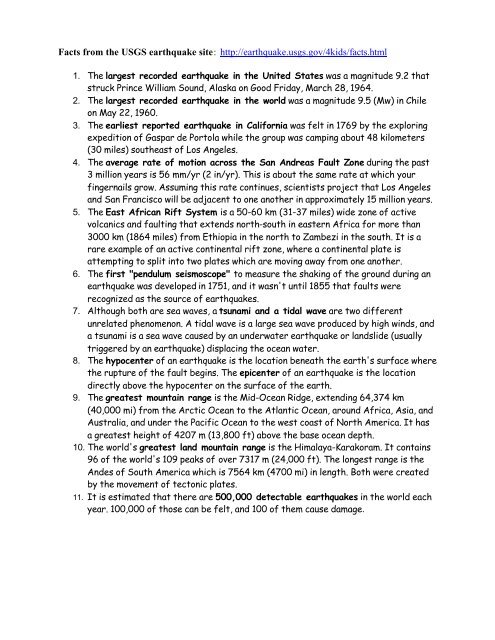Real Evidence of a Subducting Plate - Geological Society of America
Real Evidence of a Subducting Plate - Geological Society of America
Real Evidence of a Subducting Plate - Geological Society of America
Create successful ePaper yourself
Turn your PDF publications into a flip-book with our unique Google optimized e-Paper software.
Facts from the USGS earthquake site: http://earthquake.usgs.gov/4kids/facts.html<br />
1. The largest recorded earthquake in the United States was a magnitude 9.2 that<br />
struck Prince William Sound, Alaska on Good Friday, March 28, 1964.<br />
2. The largest recorded earthquake in the world was a magnitude 9.5 (Mw) in Chile<br />
on May 22, 1960.<br />
3. The earliest reported earthquake in California was felt in 1769 by the exploring<br />
expedition <strong>of</strong> Gaspar de Portola while the group was camping about 48 kilometers<br />
(30 miles) southeast <strong>of</strong> Los Angeles.<br />
4. The average rate <strong>of</strong> motion across the San Andreas Fault Zone during the past<br />
3 million years is 56 mm/yr (2 in/yr). This is about the same rate at which your<br />
fingernails grow. Assuming this rate continues, scientists project that Los Angeles<br />
and San Francisco will be adjacent to one another in approximately 15 million years.<br />
5. The East African Rift System is a 50-60 km (31-37 miles) wide zone <strong>of</strong> active<br />
volcanics and faulting that extends north-south in eastern Africa for more than<br />
3000 km (1864 miles) from Ethiopia in the north to Zambezi in the south. It is a<br />
rare example <strong>of</strong> an active continental rift zone, where a continental plate is<br />
attempting to split into two plates which are moving away from one another.<br />
6. The first "pendulum seismoscope" to measure the shaking <strong>of</strong> the ground during an<br />
earthquake was developed in 1751, and it wasn't until 1855 that faults were<br />
recognized as the source <strong>of</strong> earthquakes.<br />
7. Although both are sea waves, a tsunami and a tidal wave are two different<br />
unrelated phenomenon. A tidal wave is a large sea wave produced by high winds, and<br />
a tsunami is a sea wave caused by an underwater earthquake or landslide (usually<br />
triggered by an earthquake) displacing the ocean water.<br />
8. The hypocenter <strong>of</strong> an earthquake is the location beneath the earth's surface where<br />
the rupture <strong>of</strong> the fault begins. The epicenter <strong>of</strong> an earthquake is the location<br />
directly above the hypocenter on the surface <strong>of</strong> the earth.<br />
9. The greatest mountain range is the Mid-Ocean Ridge, extending 64,374 km<br />
(40,000 mi) from the Arctic Ocean to the Atlantic Ocean, around Africa, Asia, and<br />
Australia, and under the Pacific Ocean to the west coast <strong>of</strong> North <strong>America</strong>. It has<br />
a greatest height <strong>of</strong> 4207 m (13,800 ft) above the base ocean depth.<br />
10. The world's greatest land mountain range is the Himalaya-Karakoram. It contains<br />
96 <strong>of</strong> the world's 109 peaks <strong>of</strong> over 7317 m (24,000 ft). The longest range is the<br />
Andes <strong>of</strong> South <strong>America</strong> which is 7564 km (4700 mi) in length. Both were created<br />
by the movement <strong>of</strong> tectonic plates.<br />
11. It is estimated that there are 500,000 detectable earthquakes in the world each<br />
year. 100,000 <strong>of</strong> those can be felt, and 100 <strong>of</strong> them cause damage.
















